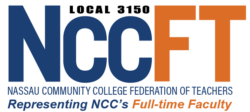Many of you have been sending questions to the NCCFT office concerning the college’s health and safety measures and protocols for the fall semester, as well as how those protocols might impact classroom management. We have been in contact with the administration in order to get you definitive answers, which we will be posting here to the blog or answering individually, as appropriate. In our last post along these lines, we discussed the ventilation study that the college commissioned in preparation for the fall semester. In this post, we discuss the QR codes that NCC’s campus physician, Dr. Neil Singhani, talked about in his all campus email of August 17 and that Vice President Lausch emailed us about earlier today. In that email, he asked us not to remove the QR codes that have been posted on the doors of classrooms where face-to-face classes will be held in the fall, since they are a new component of the college’s contact-tracing initiative. On Wednesday, March 25, your two vice presidents, Richard Newman (Classroom) and Dawn Smith (Nonclassroom/Professional Faculty) met with Dr. Singhani to get more information about this initiative.
The QR codes are part of an add-on to the NCC Mobile App, developed by Ready Education, to allow students to check in on a voluntary basis to the locations on campus where they spend their time. (Faculty, in other words, are not expected to police whether or not students scan the QR code when entering class.) That information is stored in a system that will allow NCC’s health office to contact students quickly and easily if they have been exposed either to someone with COVID-like symptoms or someone who tested positive for COVID 19. While the QR codes are being rolled out initially for classrooms, the administration has plans to place them in student service areas as well. However, because those areas have different traffic patterns in terms of student and/or visitor presence and usage, there are some logistics that still need to be worked out. Dr. Singhani also indicated that the college is investigating ways to have one-time visitors log their information into the system, but that discussion is still in the preliminary stages.
This is how the system is designed to work. Imagine that a student taking a class on Tuesdays and Thursdays from 2:30-3:45 in room N121 notifies the college either that they are having COVID-like symptoms or that they have tested positive for COVID 19. (This notification can also be sent to the college through the app.) The college can then send push notifications to all the students who scanned the QR code during that period with instructions on how to proceed that are appropriate to their vaccine status and any other contact-tracing related considerations. Faculty who use the NCC Mobile App can also scan the QR codes, of course, but it’s important to remember that the system is intended for, and the messaging is designed for, students. The college has other efficient and effective ways of contacting faculty members for contact tracing purposes.
In an effort to make sure our members are as well-informed as possible about the college’s COVID-related health and safety protocols, especially given the increase in campus density that will take place starting September 1st, VPs Newman and Smith also discussed with Dr. Singhani the contact tracing process itself as it relates to members of the faculty. Contact tracing is triggered only when someone tests positive for COVID. Once the college has been notified about this, the person who has tested positive is contacted by a member of Human Resources, who conducts an extensive interview. The first pieces of information the interviewer elicits include when the person tested positive; when they first became symptomatic; and when they were last on campus. Then, starting from 48 hours before they were symptomatic, the interviewer attempts to determine:
- Where on campus the COVID-positive person was and for how long they were there;
- Whom they consider to be a “close contact,” which is defined as someone who was within six feet of them and in the same space for 15 minutes or longer
Once that information has been collected, Human Resources begins the process of contacting those “close contacts” and giving them instructions based on their vaccine status and other considerations. It’s important to remember that contact tracing, at least in its initial stages, relies on the information provided by the person who tested positive. For example, you may hear that someone in your area tested positive and wonder why you were not contacted even though you believe you were in close contact with that individual. Most probably, this is the because that person did not provide your name to Human Resources when they were interviewed. If you believe this is the case, you should send an email to covidhr@ncc.edu immediately and someone from the Human Resources will be in touch.
As usual, we welcome discussion in the comments section, but if you have specific questions that you would like us to address, please send them to the NCCFT Office at nccft@ncc.edu.
